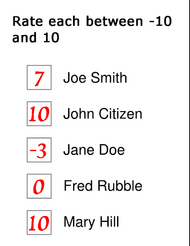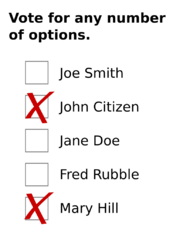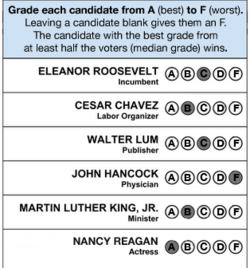Social:Cardinal voting
Cardinal voting refers to any electoral system which allows the voter to give each candidate an independent evaluation, typically a rating or grade.[1] These are also referred to as "rated" (ratings ballot), "evaluative", "graded", or "absolute" voting systems.[2][3] Cardinal methods (based on cardinal utility) and ordinal methods (based on ordinal utility) are two main categories of modern voting systems, along with plurality voting.[4][5][6]
Variants
There are several voting systems that allow independent ratings of each candidate. For example:
- Approval voting (AV) is the simplest possible method, which allows only the two grades (0, 1): "approved" or "unapproved".[7]
- Evaluative voting (EV) or combined approval voting (CAV) uses 3 grades (−1, 0, +1): "against", "abstain", or "for".[7][8][9]
- Score voting or range voting, in which ratings are numerical and the candidate with the highest average (or total[10][11]) rating wins.
- Highest median rules, which elect the candidate with the highest median grade. The various highest median rules differ in their tie-breaking methods. The majority judgment, in which the grades are associated to expressions (such as "Excellent", to "Poor"), is the most common example as it is the first such rule that has been studied, but other rules have since been proposed, e.g. the typical judgment or the usual judgment.
- STAR voting, in which scores are from 0 to 5, and the most-preferred of the top-two highest-scoring candidates wins.[16][17][18]
- Majority Approval Voting, a scored variant of Bucklin voting, typically using letter grades (such as "A" through "F").[19]
- 3-2-1 voting, in which voters rate each candidate "Good", "OK", or "Bad", and there are three automatic elimination steps to tally them: first step selects the three candidates with the most "Good" ratings, second the two with the least "Bad", and out of these the one preferred by the majority wins.[20][21]
Additionally, several cardinal systems have variants for multi-winner elections, typically meant to produce proportional representation, such as:
- Proportional approval voting
- Sequential proportional approval voting
- Satisfaction approval voting
- Re-weighted range voting[22]
Relationship to rankings
Ratings ballots can be converted to ranked/preferential ballots. For example:
| Rating (0 to 99) | Preference order | |
|---|---|---|
| Candidate A | 99 | First |
| Candidate B | 20 | Third |
| Candidate C | 20 | Third |
| Candidate D | 55 | Second |
This requires the voting system to accommodate a voter's indifference between two candidates (as in Ranked Pairs or Schulze method).
The opposite is not true: Rankings cannot be converted to ratings, since ratings carry more information about strength of preference, which is destroyed when converting to rankings.
Analysis
By avoiding ranking (and its implication of a monotonic approval reduction from most- to least-preferred candidate) cardinal voting methods may solve a very difficult problem:
A foundational result in social choice theory (the study of voting methods) is Arrow's impossibility theorem, which states that no method can comply with all of a simple set of desirable criteria. However, since one of these criteria (called "universality") implicitly requires that a method be ordinal, not cardinal, Arrow's theorem does not apply to cardinal methods.[23][24][25][26]
Others, however, argue that ratings are fundamentally invalid, because meaningful interpersonal comparisons of utility are impossible.[27] This was Arrow's original justification for only considering ranked systems,[28] but later in life he stated that cardinal methods are "probably the best".[29] Cardinal methods inherently impose a tactical concern that any voter has regarding their second-favorite candidate, in the case that there are 3 or more candidates. Score too high (or Approve) and the voter harms their favorite candidate's chance to win. Score too low (or not Approve) and the voter helps the candidate they least desire to beat their second-favorite and perhaps win.
Psychological research has shown that cardinal ratings (on a numerical or Likert scale, for instance) are more valid and convey more information than ordinal rankings in measuring human opinion.[30][31][32][33]
Cardinal methods can, but don't have to satisfy the Condorcet winner criterion.
Strategic voting
The weighted mean utility theorem gives the optimal strategy for cardinal voting, which is to give maximum score for all options above expected value of the winning option and minimum score for all other options.[34]
See also
- Borda count
References
- ↑ Baujard, Antoinette; Gavrel, Frédéric; Igersheim, Herrade; Laslier, Jean-François; Lebon, Isabelle (September 2017). "How voters use grade scales in evaluative voting". European Journal of Political Economy 55: 14–28. doi:10.1016/j.ejpoleco.2017.09.006. ISSN 0176-2680. https://halshs.archives-ouvertes.fr/halshs-01618039/file/1729.pdf. "A key feature of evaluative voting is a form of independence: the voter can evaluate all the candidates in turn ... another feature of evaluative voting ... is that voters can express some degree of preference.".
- ↑ "Cardinal voting systems—Electowiki" (in en). https://electowiki.org/wiki/Cardinal_voting_systems.
- ↑ "Voting system - Electowiki" (in en). https://electowiki.org/wiki/Voting_system#Rated_Voting_methods.
- ↑ Riker, William Harrison. (1982). Liberalism against populism : a confrontation between the theory of democracy and the theory of social choice. Waveland Pr. pp. 29–30. ISBN 0881333670. OCLC 316034736. "Ordinal utility is a measure of preferences in terms of rank orders—that is, first, second, etc. ... Cardinal utility is a measure of preferences on a scale of cardinal numbers, such as the scale from zero to one or the scale from one to ten."
- ↑ "Ordinal Versus Cardinal Voting Rules: A Mechanism Design Approach". https://www.researchgate.net/publication/316805816.
- ↑ Vasiljev, Sergei (April 2008). Cardinal Voting: The Way to Escape the Social Choice Impossibility by Sergei Vasiljev :: SSRN.
- ↑ Jump up to: 7.0 7.1 7.2 Hillinger, Claude (1 May 2005) (in en). The Case for Utilitarian Voting. Munich. doi:10.5282/ubm/epub.653. https://epub.ub.uni-muenchen.de/653/. Retrieved 15 May 2018. "Specific UV rules that have been proposed are approval voting, allowing the scores 0, 1; range voting, allowing all numbers in an interval as scores; evaluative voting, allowing the scores −1, 0, 1.".
- ↑ Hillinger, Claude (1 October 2004) (in en). On the Possibility of Democracy and Rational Collective Choice. Rochester, NY. "I favor 'evaluative voting' under which a voter can vote for or against any alternative, or abstain.".
- ↑ Felsenthal, Dan S. (January 1989). "On combining approval with disapproval voting" (in en). Behavioral Science 34 (1): 53–60. doi:10.1002/bs.3830340105. ISSN 0005-7940. "under CAV he has three options—cast one vote in favor, abstain, or cast one vote against.".
- ↑ "Range Voting". http://www.socialchoiceandbeyond.com/scabpage38.html. "with the winner being the one with the largest point total. Or, alternatively, the average may be computed and the one with the highest average wins"
- ↑ "Score Voting". The Center for Election Science. 21 May 2015. https://electology.org/score-voting. "Simplified forms of score voting automatically give skipped candidates the lowest possible score for the ballot they were skipped. Other forms have those ballots not affect the candidate’s rating at all. Those forms not affecting the candidates rating frequently make use of quotas. Quotas demand a minimum proportion of voters rate that candidate in some way before that candidate is eligible to win."
- ↑ Jump up to: 12.0 12.1 "Should you be using a more expressive voting system?". https://voteupapp.com/blog/expressive-voting. "Score Voting—it's just like range voting except the scores are discrete instead of spanning a continuous range."
- ↑ "Rating Scale Research". http://rangevoting.org/RateScaleResearch.html. "The present page seems to conclude 0-9 is the best scale."
- ↑ "Good criteria support range voting". http://rangevoting.org/PreEmProp.html. "Definition 1: For us "Range voting" shall mean the following voting method. Each voter provides as her vote, a set of real number scores, each in [0,1], one for each candidate. The candidate with greatest score-sum, is elected."
- ↑ Smith, Warren D. (December 2000). "Range Voting". http://scorevoting.net/WarrenSmithPages/homepage/rangevote.pdf. "The “range voting” system is as follows. In a c-candidate election, you select a vector of c real numbers, each of absolute value ≤1, as your vote. E.g. you could vote (+1, −1, +.3, −.9, +1) in a five-candidate election. The vote-vectors are summed to get a c-vector x and the winner is the i such that xi is maximum."
- ↑ "STAR Voting". Equal Vote Coalition. https://www.equal.vote/starvoting.
- ↑ "STAR voting an intriguing innovation" (in en). The Register Guard. http://www.registerguard.com/opinion/20180610/star-voting-intriguing-innovation.
- ↑ "Are We Witnessing the Cutting Edge of Voting Reform?" (in en-US). IVN.us. 1 February 2018. https://ivn.us/2018/02/01/cutting-edge-voting-reform/.
- ↑ "Majority Approval Voting" (in en). https://electowiki.org/wiki/Majority_Approval_Voting.
- ↑ "3-2-1 voting". 30 June 2021. https://electowiki.org/wiki/3-2-1_voting.
- ↑ Quinn, Jameson (28 May 2017). "Make. All. Votes. Count. (Part II: single-winner)". https://medium.com/@jameson.quinn/make-all-votes-count-part-2-single-winner-5a2fb47123d5.
- ↑ "Reweighted Range Voting - a PR voting method that feels like range voting". http://www.rangevoting.org/RRV.html.
- ↑ Vasiljev, Sergei (1 April 2008). Cardinal Voting: The Way to Escape the Social Choice Impossibility. Rochester, NY: Social Science Research Network.
- ↑ "Interview with Dr. Kenneth Arrow". 6 October 2012. https://electology.org/podcasts/2012-10-06_kenneth_arrow. "CES: you mention that your theorem applies to preferential systems or ranking systems. ... But the system that you're just referring to, Approval Voting, falls within a class called cardinal systems. ... Dr. Arrow: And as I said, that in effect implies more information. ... I’m a little inclined to think that score systems where you categorize in maybe three or four classes probably (in spite of what I said about manipulation) is probably the best."
- ↑ "RangeVoting.org - Arrow's theorem". http://rangevoting.org/ArrowThm.html. "according to Arrow's definition, range voting is "not" a voting system at all"
- ↑ "How I Came to Care About Voting Systems". The Center for Election Science. 21 December 2011. https://electology.org/blog/how-i-came-care-about-voting-systems. "But Arrow only intended his criteria to apply to ranking systems."
- ↑ "Why Not Ranking?" (in en). The Center for Election Science. 31 May 2016. https://electology.org/blog/why-not-ranking. "Many voting theorists have resisted asking for more than a ranking, with economics-based reasoning: utilities are not comparable between people. ... But no economist would bat an eye at asking one of the A voters above whether they'd prefer a coin flip between A and B winning or C winning outright..."
- ↑ "Modern economic theory has insisted on the ordinal concept of utility; that is, only orderings can be observed, and therefore no measurement of utility independent of these orderings has any significance. In the field of consumer's demand theory the ordinalist position turned out to create no problems; cardinal utility had no explanatory power above and beyond ordinal. Leibniz' Principle of the identity of indiscernibles demanded then the excision of cardinal utility from our thought patterns." Arrow (1967), as quoted on p. 33 by Racnchetti, Fabio (2002), "Choice without utility? Some reflections on the loose foundations of standard consumer theory", in Bianchi, Marina, The Active Consumer: Novelty and Surprise in Consumer Choice, Routledge Frontiers of Political Economy, 20, Routledge, pp. 21–45
- ↑ "Interview with Dr. Kenneth Arrow". 6 October 2012. https://electology.org/podcasts/2012-10-06_kenneth_arrow. "CES: you mention that your theorem applies to preferential systems or ranking systems. ... But ... Approval Voting, falls within a class called cardinal systems. ... Dr. Arrow: And as I said, that in effect implies more information. ... I'm a little inclined to think that score systems where you categorize in maybe three or four classes ... is probably the best."
- ↑ Conklin, E. S.; Sutherland, J. W. (1 February 1923). "A Comparison of the Scale of Values Method with the Order-of-Merit Method." (in en). Journal of Experimental Psychology 6 (1): 44–57. doi:10.1037/h0074763. ISSN 0022-1015. http://content.apa.org/journals/xge/6/1/44. "the scale-of-values method can be used for approximately the same purposes as the order-of-merit method, but that the scale-of-values method is a better means of obtaining a record of judgments".
- ↑ Moore, Michael (1 July 1975). "Rating versus ranking in the Rokeach Value Survey: An Israeli comparison" (in en). European Journal of Social Psychology 5 (3): 405–408. doi:10.1002/ejsp.2420050313. ISSN 1099-0992. "The extremely high degree of correspondence found between ranking and rating averages ... does not leave any doubt about the preferability of the rating method for group description purposes. The obvious advantage of rating is that while its results are virtually identical to what is obtained by ranking, it supplies more information than ranking does.".
- ↑ Maio, Gregory R.; Roese, Neal J.; Seligman, Clive; Katz, Albert (1 June 1996). "Rankings, Ratings, and the Measurement of Values: Evidence for the Superior Validity of Ratings". Basic and Applied Social Psychology 18 (2): 171–181. doi:10.1207/s15324834basp1802_4. ISSN 0197-3533. "Many value researchers have assumed that rankings of values are more valid than ratings of values because rankings force participants to differentiate more incisively between similarly regarded values ... Results indicated that ratings tended to evidence greater validity than rankings within moderate and low-differentiating participants. In addition, the validity of ratings was greater than rankings overall.".
- ↑ Johnson, Marilyn F.; Sallis, James F.; Hovell, Melbourne F. (1 September 1999). "Comparison of Rated and Ranked Health and Lifestyle Values". American Journal of Health Behavior 23 (5): 356–367. doi:10.5993/AJHB.23.5.5. "the test-retest reliabilities of the ranking items were slightly higher than were those of the rating items, but construct validities were lower. Because validity is the most important consideration ... the findings of the present research support the use of the rating format in assessing health values. ... added benefit of item independence, which allows for greater flexibility in statistical analyses. ... also easier than ranking items for respondents to complete.".
- ↑ Approval Voting, Steven J. Brams, Peter C. Fishburn, 1983
 |




